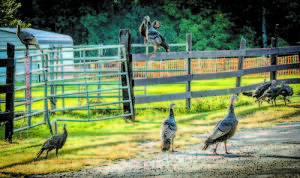Turkeys target of driver’s ire?

WATCH OUT — Wild turkeys crossing the road can be a hazard for the inattentive driver. On Bridgton’s Burnham Road Nov. 17, they may have been road kill sport.
By Gail Geraghty
Staff Writer
Eight wild turkeys were struck and killed, apparently deliberately, on the Burnham Road Nov. 17.
Whoever killed the birds, however, didn’t stick around to collect their Thanksgiving dinner — either too shocked or ashamed by what they’d done.
But the birds were tagged, and given to the person who, coming upon the scene of carnage at 8:30 a.m., did the right thing and called police.
Bridgton Police Officer Mac McCormick responded, and agreed with the caller’s assessment that the slaughter of the eight wild turkeys appeared deliberate. The caller, who waited at the scene for police to arrive, asked McCormick if he could harvest them.
“That’s when I learned something new,†said Bridgton Police Chief Richard Stillman, who up until a few months ago worked in the much more urban environment of Walpole, Mass. What he learned was that police in Maine have the authority, without involving a game warden, to tag four kinds of animals — turkey, deer, moose and bear — killed in roadside accidents.
By law, Stillman said, the driver who hits an animal is supposed to stop and call police, and then wait for police to arrive. But that doesn’t happen in many cases, and it didn’t happen that day on Burnham Road.
So McCormick tagged the turkeys and gave them to the caller, whose good deed most likely proved a boon for his family and friends this Thanksgiving Day.
Wild turkey facts
(Portions excerpted from maine.gov’s Department of Inland Fisheries & Wildlife website)
- It’s likely the flock of eight wild turkeys killed on Burnham Road were hens, since hens form flocks of six to 25 birds during late summer, fall and winter. Adult toms generally remain loners, and it is the urgent flight of a tom to catch a mate in spring that causes most serious car-turkey accidents. Hens, by contrast, stick together on the ground as they cross the road.
- Attempts to reintroduce wild turkeys to Maine have been ongoing by state wildlife officials since 1942, and the birds have become something of a common sight on rural roads, with Bridgton being no exception. Along with the Burnham Road, it’s also not unusual to see wild turkey flocks on the Sweden Road and many other rural roads.
- The average adult hen weighs between eight and 12 pounds, with adult toms weighing between 10–20 pounds. A large tom can weigh in excess of 25 pounds, and can fly up to 60 miles an hour for a mile or more. Although they’re agile flyers, turkeys often walk or run from danger. Once wild turkeys reach adulthood, they may live as long as 10 years.
As a final note, here’s some practical advice for anyone who has the misfortune of hitting and killing a wild turkey, from the website backyardchickens.com:
“At the very least, stop and make sure it’s dead, and dispatch it mercifully if it’s not. Also, why waste a life? Wild turkey tastes good — take it home and eat it, incorporate it into your dog’s food, something!â€

